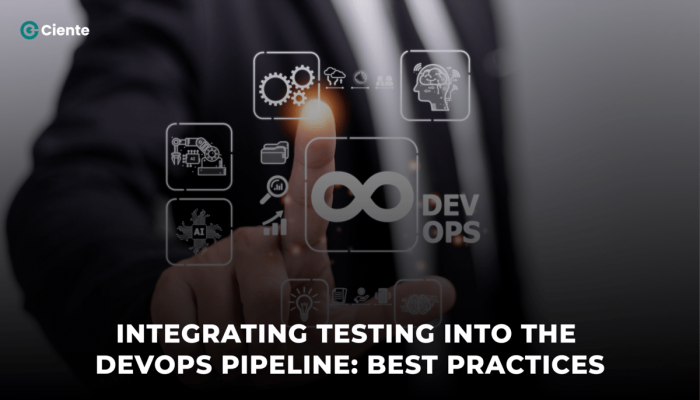 Launch apps instantly. Claim $200 credits on DigitalOcean
Launch apps instantly. Claim $200 credits on DigitalOcean
Integrating Testing into the DevOps Pipeline: Best Practices
Written by Team Ciente » Updated on: March 25th, 2024

In the fast-paced world of software development, speed and quality are both critical. DevOps, a combination of cultural philosophies, practices, and tools, aims to bridge the gap between development and operations, enabling faster and more reliable software delivery. But how does software testing devops play a role in this process? Integrating testing seamlessly into the DevOps pipeline is crucial for ensuring high-quality software while maintaining the desired pace of development.
Here are some key best practices for integrating testing into the DevOps pipeline:
1. Define a Comprehensive Testing Strategy:
Before diving into specific techniques, it’s essential to have a clear roadmap. This strategy should define:
Types of testing: Unit, integration, performance, security, and user acceptance testing (UAT) are some common types to consider.
Testing scope: What functionalities and features will be tested?
Testing frequency: How often will different tests be run (e.g., daily, after every code commit)?
Automation level: Which tests can be automated, and which require manual intervention?
2. Embrace Shift-Left Testing:
Traditional testing approaches often occurred later in the development lifecycle. In DevOps, the focus is on “shifting left” — integrating testing as early as possible. This allows for early detection and correction of bugs, saving time and resources in the long run. Techniques like unit testing and code reviews can be implemented within the development environment itself.
3. Leverage Automation:
Automating repetitive testing tasks is a cornerstone of DevOps. This frees up valuable human resources for more complex testing scenarios and problem-solving. Popular tools like Selenium, Appium, and JUnit can automate various tests, including unit, API, and UI tests.
4. Implement Continuous Integration and Deployment (CI/CD):
CI/CD pipelines automate the software development and delivery process. Every code change triggers a build, test, and potentially deployment process. This enables frequent feedback loops, allowing developers to identify and fix issues quickly. By integrating software testing devops into the CI/CD pipeline, you can ensure that only high-quality code is deployed.
5. Utilize Infrastructure as Code (IaC):
IaC treats infrastructure provisioning and configuration as code, enabling consistent and repeatable environments for testing. Tools like Terraform and Ansible allow you to define test environments through code, ensuring consistency and avoiding manual configuration errors.
6. Employ Effective Test Management Tools:
Managing and monitoring various tests throughout the pipeline is crucial. Tools like TestRail, Zephyr, and Jenkins provide features for test case management, execution tracking, and reporting. These tools help visualize the testing process and identify areas for improvement.
7. Foster Collaboration and Shared Responsibility:
DevOps emphasizes collaboration between development, operations, and testing teams. Encouraging shared ownership of software quality fosters a culture of continuous improvement and ensures that everyone is invested in delivering high-quality software.
8. Continuously Monitor and Improve:
Testing in DevOps is an iterative process. Continuously monitor test results, identify bottlenecks, and strive to improve testing efficiency. Analyze trends, learn from failures, and adapt your testing strategy based on evolving needs and project progress.
By following these best practices, you can effectively integrate software testing devops into your DevOps pipeline. This will enable you to deliver high-quality software faster, achieve better release predictability, and ultimately, ensure a successful and efficient software development process.
AUTHOURS BIO:
With our best tech publication, Ciente , business leaders stay abreast of tech news , Events and market insights that help them level up now.
Technology spending is increasing, but so is buyer’s remorse. We are here to change that. Founded on truth, accuracy, and tech prowess, Ciente is your go-to periodical for effective decision-making.
Our comprehensive editorial coverage, market analysis, and tech insights empower you to make smarter decisions to fuel growth and innovation across your enterprise.
Let us help you navigate the rapidly evolving world of technology and turn it to your advantage.
Copyright © 2024 IndiBlogHub.com Hosted on Digital Ocean









Post a Comment
To leave a comment, please Login or Register